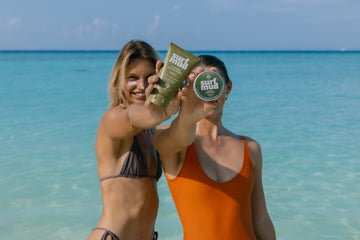Sunscreen Active Ingredients: FDA’s proposed Sunscreen Order - a game changer for skin safety.
Short on Time
Not all sunscreens are created equal. The FDA’s latest findings reveal alarming levels of chemical absorption in the bloodstream—leaving zinc oxide as the clear, safe choice to protect your skin and our oceans.
The lowdown
The FDA’s proposed order on sunscreen regulation marks a critical shift toward safer sun protection. Only zinc oxide and titanium dioxide remain classified as “Generally Recognised as Safe and Effective” (GRASE), while several chemical filters face removal due to insufficient safety data or potential risks. This decision underscores the growing need for transparency and reliability in sunscreen formulations - and highlights why products like Surfmud, which rely exclusively on non-nano zinc oxide, are ahead of the curve.
The problem with chemical Filters
Research reveals that some chemical filters, including oxybenzone, avobenzone, and octocrylene, are absorbed into the bloodstream at concerning levels. Oxybenzone, for example, has been detected at concentrations exceeding 200 ng/mL—over 400 times the FDA’s safety threshold of 0.5 ng/mL. Such systemic exposure raises questions about potential endocrine disruption and other long-term health impacts. Avobenzone, another widely used chemical, also surpassed acceptable thresholds by more than eightfold in testing. These findings have prompted the FDA to propose excluding 14 chemical filters, including homosalate, octinoxate, and oxybenzone, from the GRASE list unless manufacturers can provide comprehensive safety data.
Why zinc oxide is the gold standard
Unlike chemical filters, non-nano zinc oxide provides reliable broad-spectrum protection by physically reflecting harmful UVA and UVB rays off the skin. It does not penetrate the skin, remaining on the surface to safeguard users without posing systemic risks. Zinc oxide is also reef-safe, making it an environmentally responsible choice that aligns with growing consumer demand for sustainability.
The Surfmud difference
Surfmud exclusively uses non-nano zinc oxide in its sunscreen formulations, delivering superior sun protection that is safe for your skin and the environment. Our products are designed for surfers, outdoor enthusiasts, and anyone seeking natural, effective sun protection. With Surfmud, you can trust you’re using a product that meets the highest standards for safety and efficacy while protecting marine ecosystems.
Watch out for these ingredients
Before purchasing sunscreen, check the label for these common chemical filters flagged by the FDA:
Oxybenzone | Octinoxate | Avobenzone | Octocrylene | Homosalate | Octisalate
Switching to zinc oxide-based sunscreens like Surfmud is a simple way to protect yourself and the planet.
Hear it from an expert
References
- FDA. An Update on Sunscreen Requirements: The Deemed Final Order and the Proposed Order. FDA Website
- Matta MK, Florian J, Zusterzeel R, et al. Effect of Sunscreen Application Under Maximal Use Conditions on Plasma Concentration of Sunscreen Active Ingredients: A Randomized Clinical Trial. JAMA. 2020;323(3):256–267. JAMA Network
- FDA. Shedding More Light on Sunscreen Absorption. FDA Website
- News-Medical. Sunscreen ingredients absorbed into blood finds study from FDA. News-Medical
- Human Epidermal Zinc Concentrations after Topical Application of ZnO Nanoparticles in Sunscreens. International Journal of Molecular Science
- The Huberman Lab. Dr. Teo Soleymani: How to Improve & Protect Your Skin Health & Appearance. The Huberman Lab
Note: All sunscreens in Australia are regulated by the Therapeutic Goods Administration (TGA). They set the maximum concentration limits allowed for active ingredients in sunscreen products (medicines). These can be seen on page 38 of the Australian regulatory guidelines for sunscreens. Zinc oxide is the only ingredient that does not have a maximum concentration limit.
By choosing Surfmud, you’re not just safeguarding your skin—you’re making a responsible choice for a healthier world.


